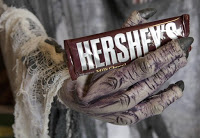Halloween treats can be healthy, and trick-or-treaters with diabetes can still be part of the fun

 It wouldn’t be Halloween without candy and chocolate in pillowcases and paper sacks. But with childhood obesity and diabetes rates looking as scary as the ax murderers and zombies knocking at the door, parents may consider handing out something other than the usual calorie-packed treats this year.
It wouldn’t be Halloween without candy and chocolate in pillowcases and paper sacks. But with childhood obesity and diabetes rates looking as scary as the ax murderers and zombies knocking at the door, parents may consider handing out something other than the usual calorie-packed treats this year.
Courtney Cairns Pastor of The Associated Press suggests five non-candy foods “that won’t get your house egged,” including pretzel packs, single-serving bags of Goldfish snack crackers, freeze-dried fruit, snack-size microwave popcorn bags and squeezable applesauce. (AP photo) She also suggests handing out items that aren’t food related at all, including stickers, temporary tattoos, crayons, bubbles and Play-Doh.
Still, eating a bit of candy on Halloween is tradition — and one still going strong. The National Retail Federation reported Americans spent nearly $1.8 billion on Halloween candy in 2010, spending an average of $20.29 per person.
Though one in four children are diabetic, they needn’t skip tradition entirely, research-reporting service Newswise reports. “They can enjoy Halloween and enjoy some of the sweets the holiday offers — within reason,” said Dr. Kenneth McCormick, pediatric endocrinologist and senior scientist at the Comprehensive Diabetes Center at the University of Alabama at Birmingham.
McCormick said kids can opt to count their carbohydrate calories; exchange candy for other treats; or save their candy for dessert. By counting carbs, a child pays attention to how much they are consuming and “take, for example, one unit of insulin for every 15 to 20 grams of carbohydrates,” Newswise reports. “This is an easy option for kids on an insulin pump because they can just dial in an extra dose of insulin to compensate for what they are about to eat,” McCormick said.
Parents can “trade the child a gift, money or low-carb snack for their candy,” McCormick suggested. “We have been advising parents to do this for many, many years, and it is a solution that continues to work.” Diabetic kids can also avoid problems if they eat their Halloween treats after they have eaten dinner. “By incorporating a sugary treat into meal time, when a child would normally get a dose of insulin, it eliminates the need for adding doses to their regimen,” McCormick said. (Read more)
